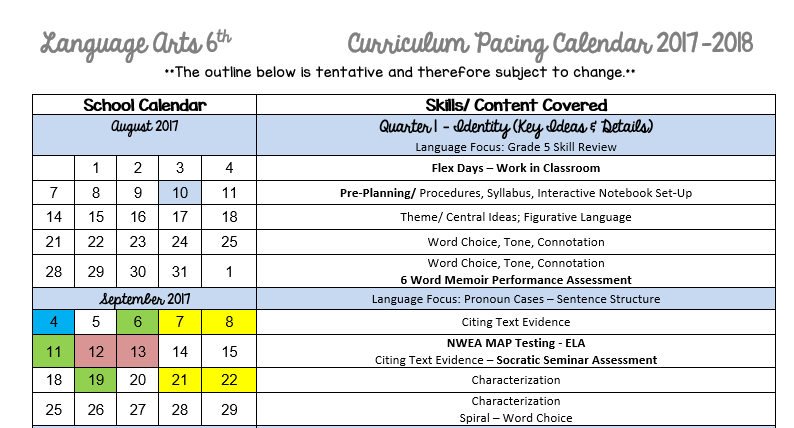Tamara Griffith
Planning For Instruction
InTASC Standard 7: The teacher plans instruction that supports every student in meeting rigorous learning goals by drawing upon knowledge of content areas, curriculum, cross-disciplinary skills, and pedagogy, as well as knowledge of learners and the community context
Introduction:
Effective planning is the backbone of transformational teaching and learning. In order to plan for instruction and develop learning experiences that best cater to my students' diverse needs, I strive to ensure that my plans draw upon content knowledge, utilize cross-disciplinary skills, and apply a pedagogical framework that supports all students in achieving rigorous learning goals. To this end, I utilize the backwards design model to plan for instruction. This model allows me to ensure that my instruction is aligned to both the Language Arts Florida Standards and my classroom Big Goals, thereby promoting student success. Moreover, I apply the backwards design framework to create long-term, unit, and lesson plans.
Typically, planning for instruction begins over the summer with the creation of my long-term plan. Essentially, my long-term plan maps out how my instruction will meet the overarching goals of the standards throughout the year. By beginning with a long-term plan that effectively incorporates and accounts for the overarching goals of the standards, I can outline the appropriate sequence of content and skills to be taught over the course of the school year, thus supporting students' attainment of rigorous learning goals. In addition, this yearly outline of instruction contains a unit overview, which allows me to remain focused on meeting the standards' overarching goals and to plan for effective collaboration with colleagues.
After I have ensured my instruction will be appropriately sequenced to support students' attainment of my class's long-term goals, I use the backwards design model to develop unit plans. When backwards designing unit plans, I begin by designing a unit summative assessment that is aligned to the standards and will help students achieve the overarching goals of the standards. Once the unit summative assessment has been designed, I plan the scaffolds necessary to ensure students can successfully meet the objectives of both the unit assessment and the standards' overarching goals. Typically, my unit plans contain a unit overview, the standards -- including cross-curricular standards -- addressed, essential questions, enduring understandings, and a daily outline of learning objectives that will lead to students' successful completion of the unit summative assessment.
Knowing precisely where my students need to go and grow through long-term and unit planning, I can then develop effective lesson plans that tailor instruction to meet students' diverse needs, thereby fostering academic achievement. The backwards design framework also plays a role in my lesson planning; I begin planning lessons by designing the lesson assessment. These lesson assessments are typically formative assessments, which often take the form of an exit ticket or independent practice. Once the lesson assessment has been crafted, I scaffold learning activities to ensure that students will be able to complete the lesson assessment successfully.
Clearly, there are many variables that go into effectively planning for instruction. For example, content knowledge, knowledge of the standards, knowledge of my diverse learners, and knowledge of cross-disciplinary skills all support my ability to effectively plan for instruction in a way that enables my scholars to meet rigorous academic goals. As one individual, I cannot purport to possess everything there is to know in all of these areas; consequently, in order to more effectively plan for instruction, I collaborate with a variety of individuals, such as colleagues, parents, and my personal learning network, to gain additional insights and perspectives in these areas, which I then integrate into my instructional plans. This collaboration holds me accountable and ensures that my students are consistently working toward rigorous academic goals in ways that differentiate for their abilities, needs, and disparate cultures.
Click on the images below to explore how long-term, unit, lesson, and collaborative planning occurs within my language arts classroom.
Table of Contents:
Conclusion:
Clearly, effectively planning for instruction is beneficial to both my pedagogy and students' success. Whether I am planning long-term, unit, or lesson plans, I utilize the backwards design framework. This framework is crucial to my planning as its usage ensures that my long-term and short-term plans are effective and continuously challenge my students to meet rigorous academic goals. An effective long-term plan provides me with a year-long outlook of what I will be teaching, allowing me to more efficiently utilize instructional time and ensure that meaningful cross-curricular skills and connections have been included. Effective unit plans depict the essential questions, objectives, and timeline necessary for students to be able to successfully master the standards and objectives contained within the unit summative assessment. Finally, effective lesson plans allows me to take into account the disparate needs, interests, and cultures of my students, which, in turn, allows me to later develop meaningful instructional strategies that will provide them with greater access to and investment in the content. Together, all of these components, long-term, unit, lesson, and collaborative planning, provide the backbone of my transformational teaching craft.



